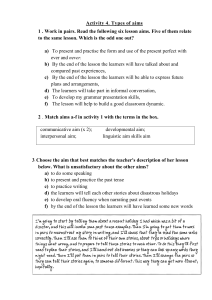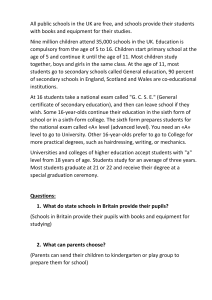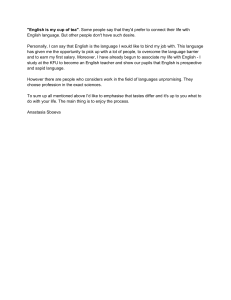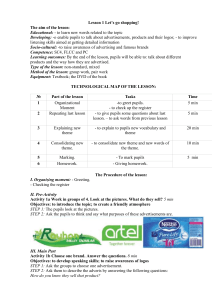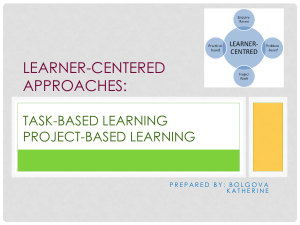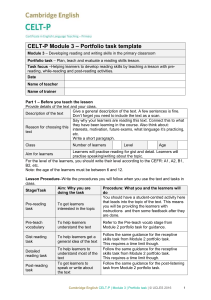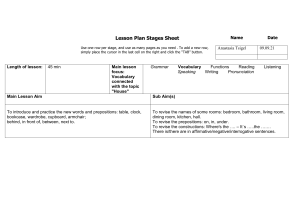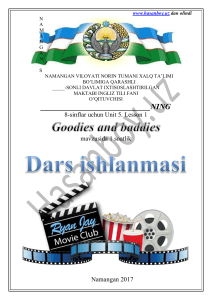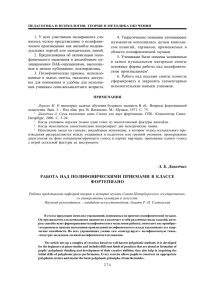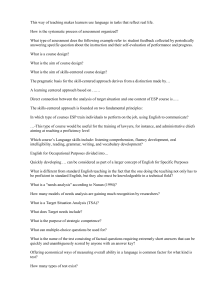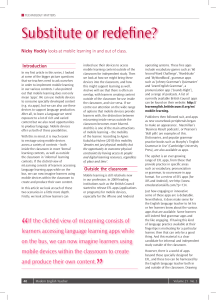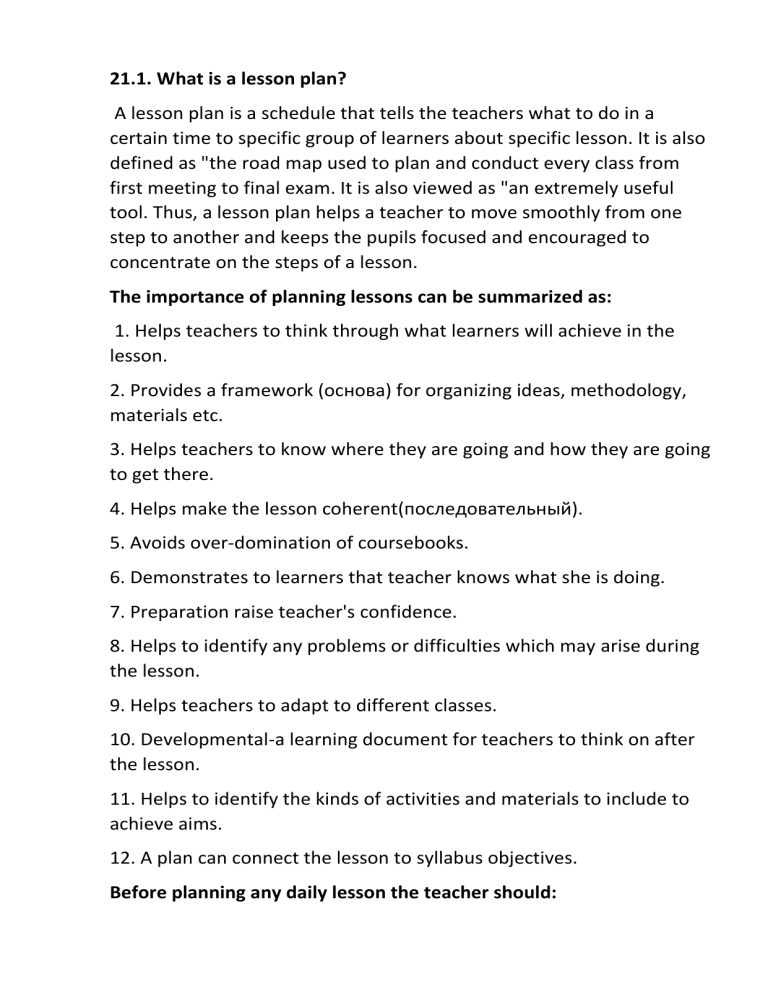
21.1. What is a lesson plan? A lesson plan is a schedule that tells the teachers what to do in a certain time to specific group of learners about specific lesson. It is also defined as "the road map used to plan and conduct every class from first meeting to final exam. It is also viewed as "an extremely useful tool. Thus, a lesson plan helps a teacher to move smoothly from one step to another and keeps the pupils focused and encouraged to concentrate on the steps of a lesson. The importance of planning lessons can be summarized as: 1. Helps teachers to think through what learners will achieve in the lesson. 2. Provides a framework (основа) for organizing ideas, methodology, materials etc. 3. Helps teachers to know where they are going and how they are going to get there. 4. Helps make the lesson coherent(последовательный). 5. Avoids over-domination of coursebooks. 6. Demonstrates to learners that teacher knows what she is doing. 7. Preparation raise teacher's confidence. 8. Helps to identify any problems or difficulties which may arise during the lesson. 9. Helps teachers to adapt to different classes. 10. Developmental-a learning document for teachers to think on after the lesson. 11. Helps to identify the kinds of activities and materials to include to achieve aims. 12. A plan can connect the lesson to syllabus objectives. Before planning any daily lesson the teacher should: 1. Read the lesson notes and the lesson materials and listen to the Cassette Section where need. 2. Think about the learning objectives and consider whether the recommended procedure will achieve this aim. If necessary, change the procedure to suit the particular needs of your pupils. 3. Think about any difficulties your pupils may have and decide how you can best present the materials to deal with these. If the book advises asking questions and need one or two examples, prepare other suitable questions and write them in your plan. 4. Count the time needed for each step of your lesson. If you want to set homework, prepare it now. 5. Make sure that your plan contains enough time for pupil to pupil interaction. 6. Make sure also that there is a variety of activities in the lesson. 21.2. Why preparing lesson-plans? Preparing lesson-plans organizes the time of the classroom and helps teachers to achieve their lessons efficiently with the given time. O'Neill, suggests that "Good lesson planning lead to effective use of classroom time. Students to a well-organized lesson where no time is wasted and the teacher's job is thus made less difficult. Distinguish 3 types/ kinds of planning: long-term, thematic and lesson planning. - Long-term planning is for longer period of time and provides the distribution(распределение) of the material for a year. -Thematic planning allows to create a series of lessons united by one topic which allows the teacher to present clearly the work on the topic, to define the role and place of each lesson in the system. Thematic plan represents a system of lessons on the topic in general, has its structure - A lesson plan is a detailed step-by-step guide that contains the teacher's objectives for what the students will accomplish during the course of the lesson and how they will learn it. Creating a lesson plan involves setting goals, developing activities, and determining the materials that you will use. 22.1. Effective lesson planning Good lesson planning is essential to the process of teaching and learning. A teacher who is prepared is well on his way to a successful instructional experience. The development of interesting lessons takes a great deal of time and effort. The lesson should contain interesting tasks and activities Suggested practices 1) Establish a positive classroom environment - Make the classroom a pleasant, friendly place - Accept individual differences -Establish classroom rules and procedures and consistently reinforce them 2)Begin lessons by giving clear instructions - Specify desired quality of work -Ensure that all distractions(отвлекания) have removed -Start with a highly motivating activity 3)Maintain student attention -Use random selection in calling upon students - Demonstrate the types of response - Be active , show interes inthusiasm 4)Use appropriate pacing (шаг) - Be aware of your teaching tempo -Watch for cues(признаки) that children are becoming confused, bored 5) Provide suitable seatwork - Seatwork should be diagnostic and perscriptive -Develop procedure for what to do when finished -Move around to monitor seatworks 6)Evaluate what has taken place in your lesson -Summarize the lesson and focus on positive results made by students. -Determine if the lesson was successful; were goals accomplished? 7)Make a smooth transition into next subject -Have materials ready for next lesson - Keep attention of students until you have given clear instructions for the next activity -Move around and attend to individual needs 8)Develop positive teacher/student relationships - Set a good example; be a positive model - Create an exciting learning environment for all students - Appreciate with marks good behavior; create special activities that children will enjoy doing 9) Keep in short and simple 10) Use a warning system (оповещение) 11) Defer disruptive behavior proactively(Заблаговременно откладывайте деструктивное поведение) 12) Help students be successful
